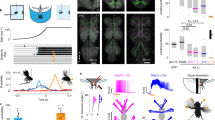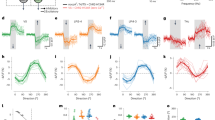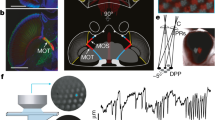Abstract
We developed a technique for performing whole-cell patch-clamp recordings from genetically identified neurons in behaving Drosophila. We focused on the properties of visual interneurons during tethered flight, but this technique generalizes to different cell types and behaviors. We found that the peak-to-peak responses of a class of visual motion–processing interneurons, the vertical-system visual neurons (VS cells), doubled when flies were flying compared with when they were at rest. Thus, the gain of the VS cells is not fixed, but is instead behaviorally flexible and changes with locomotor state. Using voltage clamp, we found that the passive membrane resistance of VS cells was reduced during flight, suggesting that the elevated gain was a result of increased synaptic drive from upstream motion-sensitive inputs. The ability to perform patch-clamp recordings in behaving Drosophila promises to help unify the understanding of behavior at the gene, cell and circuit levels.
This is a preview of subscription content, access via your institution
Access options
Subscribe to this journal
Receive 12 print issues and online access
$209.00 per year
only $17.42 per issue
Buy this article
- Purchase on Springer Link
- Instant access to full article PDF
Prices may be subject to local taxes which are calculated during checkout






Similar content being viewed by others
References
Strausfeld, N.J. Atlas of an Insect Brain 214 (Springer-Verlag, 1976).
Taylor, G.K. & Krapp, H.G. Sensory systems and flight stability: what do insects measure and why? in Insect Mechanics and Control: Advances in Insect Physiology, Vol. 34 (eds. Casas, J. & Simpson, S.J.) 231–316 (Academic Press, London, 2007).
Borst, A. & Haag, J. Neural networks in the cockpit of the fly. J. Comp. Physiol. A Neuroethol. Sens. Neural Behav. Physiol. 188, 419–437 (2002).
Hausen, K. Decoding of retinal image flow in insects. Rev. Oculomot. Res. 5, 203–235 (1993).
Krapp, H.G. & Wicklein, M. in The Senses: a Comprehensive Reference (eds. Basbaum, A.I., Kaneko, A. & Shepherd, G.M.) 131–204 (Academic Press, London, 2008).
Balint, C.N. & Dickinson, M.H. The correlation between wing kinematics and steering muscle activity in the blowfly Calliphora vicina. J. Exp. Biol. 204, 4213–4226 (2001).
Frye, M.A. in Avances in Invertebrate Neurobiology (eds Greenspan, R. & North, G.) (Cold Spring Harbor Laboratory Press, Cold Spring Harbor, New York, 2007).
Gotz, K.G. Flight control in Drosophila by visual perception of motion. Kybernetik 6, 199–208 (1968).
Tammero, L.F. & Dickinson, M.H. Collision-avoidance and landing responses are mediated by separate pathways in the fruit fly, Drosophila melanogaster. J. Exp. Biol. 205, 2785–2798 (2002).
Budick, S.A. & Dickinson, M.H. Free-flight responses of Drosophila melanogaster to attractive odors. J. Exp. Biol. 209, 3001–3017 (2006).
Wilson, R.I., Turner, G.C. & Laurent, G. Transformation of olfactory representations in the Drosophila antennal lobe. Science 303, 366–370 (2004).
Joesch, M., Plett, J., Borst, A. & Reiff, D.F. Response properties of motion-sensitive visual interneurons in the lobula plate of Drosophila melanogaster. Curr. Biol. 18, 368–374 (2008).
Turner, G.C., Bazhenov, M. & Laurent, G. Olfactory representations by Drosophila mushroom body neurons. J. Neurophysiol. 99, 734–746 (2008).
Ramirez, J.M. & Pearson, K.G. Alteration of bursting properties in interneurons during locust flight. J. Neurophysiol. 70, 2148–2160 (1993).
Treue, S. & Maunsell, J.H. Attentional modulation of visual motion processing in cortical areas MT and MST. Nature 382, 539–541 (1996).
Schmidt, M.F. & Konishi, M. Gating of auditory responses in the vocal control system of awake songbirds. Nat. Neurosci. 1, 513–518 (1998).
Rowell, C.H.F. Variable responsiveness of a visual interneurone in the free-moving locust and its relation to behaviour and arousal. J. Exp. Biol. 55, 727–747 (1971).
Rind, F.C., Santer, R.D. & Wright, G.A. Arousal facilitates collision avoidance mediated by a looming sensitive visual neuron in a flying locust. J. Neurophysiol. 100, 670–680 (2008).
Rosner, R., Egelhaaf, M. & Warzecha, A.K. Behavioural state affects motion-sensitive neurones in the fly visual system. J. Exp. Biol. 213, 331–338 (2010).
Tomioka, K. & Yamaguchi, T. Response modification of cricket sensory interneurons during flight. Zoolog. Sci. 1, 169–186 (1984).
Hengstenberg, R. Common visual response properties of giant vertical cells in the lobula plate of the blowfly Calliphora. J. Comp. Physiol. A. Neuroethol. Sens. Neural Behav. Physiol. 149, 179–193 (1982).
Scott, E.K., Raabe, T. & Luo, L. Structure of the vertical and horizontal system neurons of the lobula plate in Drosophila. J. Comp. Physiol. 454, 470–481 (2002).
Haag, J. & Borst, A. Neural mechanism underlying complex receptive field properties of motion-sensitive interneurons. Nat. Neurosci. 7, 628–634 (2004).
Krapp, H.G. & Hengstenberg, R. Estimation of self-motion by optic flow processing in single visual interneurons. Nature 384, 463–466 (1996).
Hausen, K. The lobula-complex of the fly: structure, function and significance in visual behavior. in Photoreception and Vision in Invertebrates (ed. Ali, M.A.) (Plenum Press, New York, 1984).
Hengstenberg, R. Spike responses of nonspiking visual inter-neurone. Nature 270, 338–340 (1977).
Haag, J., Theunissen, F. & Borst, A. The intrinsic electrophysiological characteristics of fly lobula plate tangential cells. 2. Active membrane properties. J. Comput. Neurosci. 4, 349–369 (1997).
Gotz, K.G. Course-control, metabolism and wing interference during ultralong tethered flight in Drosophila melanogaster. J. Exp. Biol. 128, 35–46 (1987).
Graetzel, C.F., Fry, S.N. & Nelson, B.J. A 6,000-Hz computer vision system for real-time wing beat analysis of Drosophila. in BioRob. The First IEEE/RAS-EMBS Internation Conference on Biomdeical Robotics and Biomechatronics 1–6 (Institute of Electrical and Electronics Engineers, Pisa, Italy, 2006).
Heisenberg, M., Wonneberger, R. & Wolf, R. Optomotor-blindH31—a Drosophila mutant of the lobula plate giant neurons. J. Comp. Physiol. A. Neuroethol. Sens. Neural Behav. Physiol. 124, 287–296 (1978).
Gordon, S. & Dickinson, M.H. Role of calcium in the regulation of mechanical power in insect flight. Proc. Natl. Acad. Sci. USA 103, 4311–4315 (2006).
North, R.A. & Uchimura, N. 5-Hydroxytryptamine acts at 5-HT2 receptors to decrease potassium conductance in rat nucleus accumbens neurones. J. Physiol. (Lond.) 417, 1–12 (1989).
Krapp, H.G., Hengstenberg, B. & Hengstenberg, R. Dendritic structure and receptive-field organization of optic flow processing interneurons in the fly. J. Neurophysiol. 79, 1902–1917 (1998).
Longden, K.D. & Krapp, H.G. State-dependent performance of optic-flow processing interneurons. J. Neurophysiol. 102, 3606–3618 (2009).
Busch, S., Selcho, M., Ito, K. & Tanimoto, H. A map of octopaminergic neurons in the Drosophila brain. J. Comp. Neurol. 513, 643–667 (2009).
Orchard, I., Ramirez, J.M. & Lange, A.B. A multifunctional role for octopamine in locust flight. Annu. Rev. Entomol. 38, 227–249 (1993).
Brembs, B., Christiansen, F., Pfluger, H.J. & Duch, C. Flight initiation and maintenance deficits in flies with genetically altered biogenic amine levels. J. Neurosci. 27, 11122–11131 (2007).
Harris, R.A., O'Carroll, D.C. & Laughlin, S.B. Contrast gain reduction in fly motion adaptation. Neuron 28, 595–606 (2000).
Niven, J.E. & Laughlin, S.B. Energy limitation as a selective pressure on the evolution of sensory systems. J. Exp. Biol. 211, 1792–1804 (2008).
Fetcho, J.R., Higashijima, S. & McLean, D.L. Zebrafish and motor control over the last decade. Brain Res. Rev. 57, 86–93 (2008).
Benzer, S. Behavioral mutants of Drosophila isolated by countercurrent distribution. Proc. Natl. Acad. Sci. USA 58, 1112–1119 (1967).
Liu, G. et al. Distinct memory traces for two visual features in the Drosophila brain. Nature 439, 551–556 (2006).
Neuser, K., Triphan, T., Mronz, M., Poeck, B. & Strauss, R. Analysis of a spatial orientation memory in Drosophila. Nature 453, 1244–1247 (2008).
Strausfeld, N.J., Sinakevitch, I. & Okamura, J.Y. Organization of local interneurons in optic glomeruli of the dipterous visual system and comparisons with the antennal lobes. Dev. Neurobiol. 67, 1267–1288 (2007).
Reiser, M.B. & Dickinson, M.H. A modular display system for insect behavioral neuroscience. J. Neurosci. Methods 167, 127–139 (2008).
Maimon, G., Straw, A.D. & Dickinson, M.H. A simple vision-based algorithm for decision making in flying Drosophila. Curr. Biol. 18, 464–470 (2008).
Fry, S.N., Sayaman, R. & Dickinson, M.H. The aerodynamics of free-flight maneuvers in Drosophila. Science 300, 495–498 (2003).
Straw, A.D. & Dickinson, M.H. Motmot, an open-source toolkit for real-time video acquisition and analysis. Source Code Biol. Med. 4, 5 (2009).
Wilson, R.I. & Laurent, G. Role of GABAergic inhibition in shaping odor-evoked spatiotemporal patterns in the Drosophila antennal lobe. J. Neurosci. 25, 9069–9079 (2005).
Barry, P.H. & Lynch, J.W. Liquid junction potentials and small-cell effects in patch-clamp analysis. J. Membr. Biol. 121, 101–117 (1991).
Acknowledgements
We thank J. Assad, V. Bhandawat, G. Card, C. Chiu, M. Do, T. Herrington, W. Korff, G. Laurent, M. Murthy, P. Polidoro, G. Turner and R. Wilson for helpful discussion, comments and aid in developing the preparation. We are grateful to L. Luo for the Gal4-3a fly line. This work was supported by a National Science Foundation Frontiers in Integrative Biological Research 0623527 award (M.H.D.) and a Caltech Della Martin fellowship (G.M.).
Author information
Authors and Affiliations
Contributions
G.M., A.D.S. and M.H.D. designed the experiments. G.M. and M.H.D. wrote the paper. G.M. developed the preparation, conducted the experiments and analyzed the data. A.D.S. designed the software and hardware system for tracking wing beat amplitudes in real time.
Corresponding author
Ethics declarations
Competing interests
The authors declare no competing financial interests.
Supplementary information
Supplementary Text and Figures
Supplementary Figures 1–4 (PDF 3624 kb)
Supplementary Video 1
Fly flying during a patch-clamp recording. This video shows footage of a flying fly during an electrophysiological recording session. The green lines represent the estimates of the left and right wingbeat amplitudes. (MOV 3741 kb)
Rights and permissions
About this article
Cite this article
Maimon, G., Straw, A. & Dickinson, M. Active flight increases the gain of visual motion processing in Drosophila. Nat Neurosci 13, 393–399 (2010). https://doi.org/10.1038/nn.2492
Received:
Accepted:
Published:
Issue Date:
DOI: https://doi.org/10.1038/nn.2492
This article is cited by
-
Motor neurons generate pose-targeted movements via proprioceptive sculpting
Nature (2024)
-
A rise-to-threshold process for a relative-value decision
Nature (2023)
-
Ascending neurons convey behavioral state to integrative sensory and action selection brain regions
Nature Neuroscience (2023)
-
Multilevel visual motion opponency in Drosophila
Nature Neuroscience (2023)
-
Threat gates visual aversion via theta activity in Tachykinergic neurons
Nature Communications (2023)



